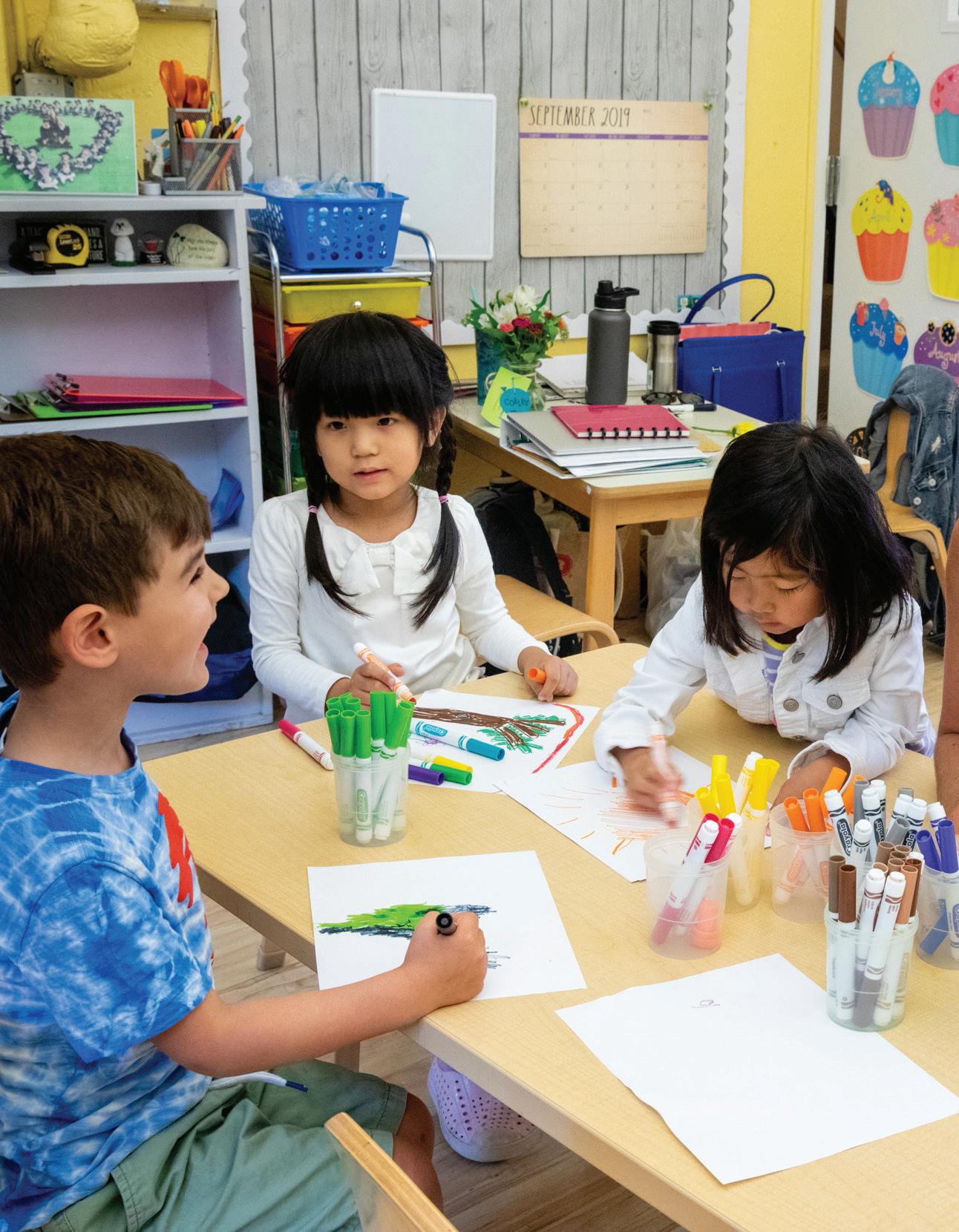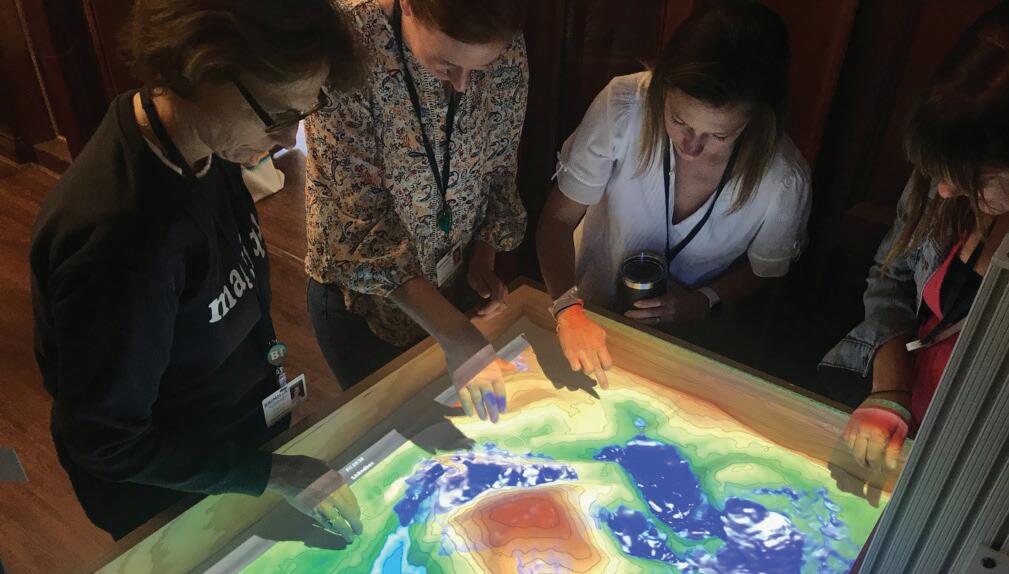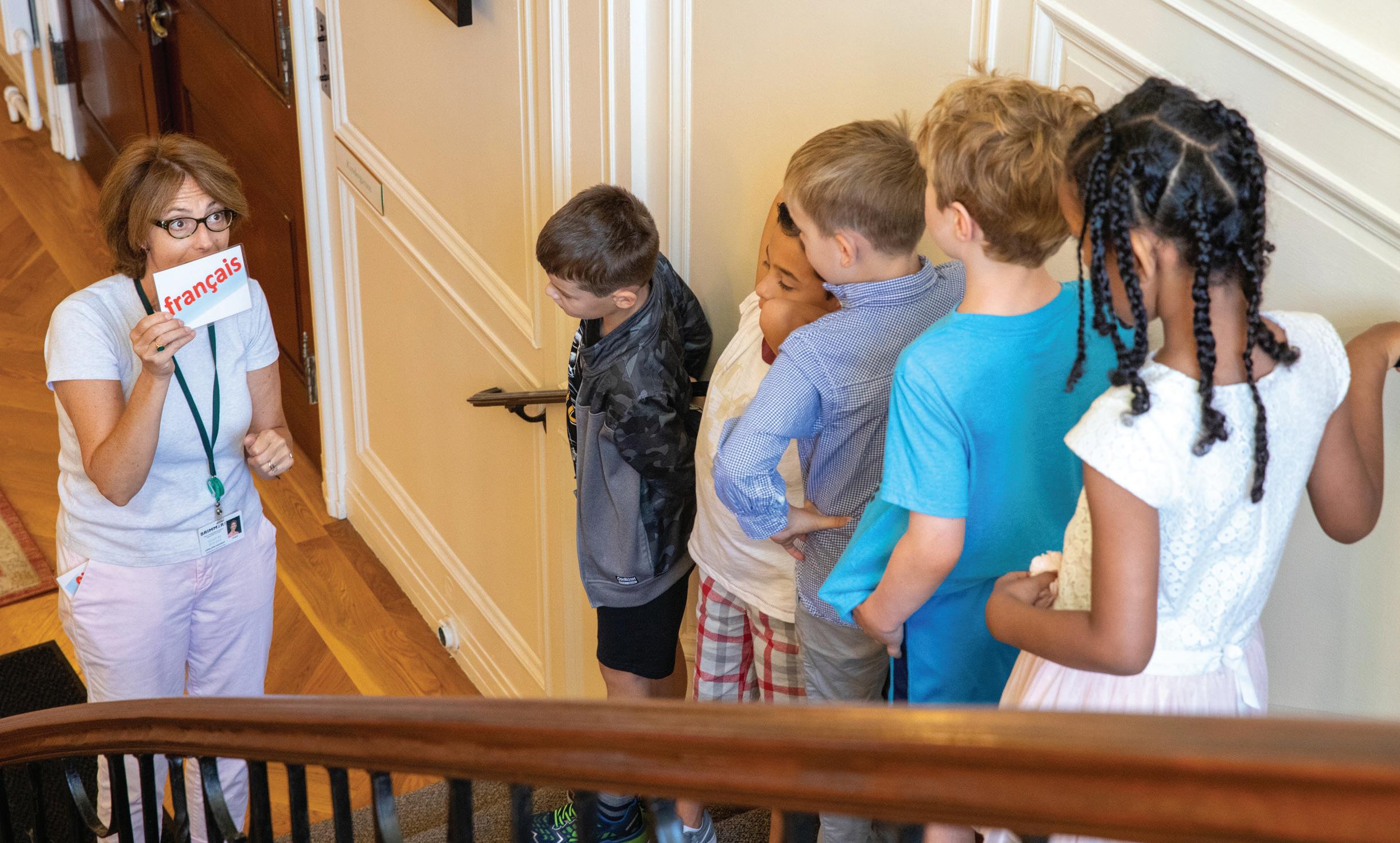
5 minute read
Inspired to Learn: Laying the Foundation for the Future
Picture yourself in the midst of a buzzing first grade classroom on a Friday afternoon. The children watch with great anticipation as the Mystery Reader enters dramatically, and the students squeal with delight. For three consecutive days students received clues about their visitor’s identity, and finally they have their answer. They settle down in a circle, and the story begins. To an observer, it might seem like a fun, time-honored tradition. But a closer look reveals that it’s a small part of Brimmer’s rich and engaging approach to Early Childhood Education, a cornerstone of the School’s PK-12 academic program.

PK students thrive in a joyful learning environment, where teachers help nurture a love for learning that will inspire them through their schooling.
David Barron/Oxygen Group Photography
“Our Early Childhood Program sets a foundation for each child’s future cognitive and social development,” notes Head of School Judith Guild, emphasizing the program’s broader purpose and philosophy. “The belief that play is the foundation for learning determines how the School approaches instruction with young children. Using an integrated, hands-on, and purposeful curriculum, our teachers are experts at developing a love for learning in students that will inspire them throughout their schooling and set them up for success.”
In its list of the top ten skills needed for the future, the World Economic Forum includes “complex problem solving” and “critical thinking” as the top two. That’s no surprise to Brimmer faculty as these skills are rooted in the School’s mission and guiding principles. Students are challenged daily to become problem solvers while working independently and collaboratively, and the foundation for successful and joyful learning begins with the youngest learners.
Purposeful curriculum is the key to the program’s success. Brimmer’s educators have designed thoughtful curriculum in both Language Arts and Math, with a scope and sequence that builds skills and reinforces concepts both within and across grade levels. The Language Arts curriculum paves the way for students to become independent, joyful readers and writers. With a hands-on, multisensory, and thematic approach, PK students focus on developing concepts of print, identifying and forming letters of the alphabet, and learning about phonics and developing phonemic awareness. These skills are further developed in Kindergarten where students delve more deeply into sound-symbol association, sight words, vocabulary, comprehension, written expression, and handwriting. Read-alouds, book discussions, reading groups, independent reading, and journaling help cultivate a life-long love of reading and writing. In Kindergarten and Grade 1, students meet with teachers in small groups and rotate through enriching, creative, literacy centers—updated regularly to reinforce concepts. First graders strengthen their reading skills by practicing reading strategies and word-attack skills and work on expressing their ideas during Writer’s Workshop.
The Math curriculum follows a similar trajectory. Math content transitions from early numeracy in PK, to computation in Kindergarten, and develops into more sophisticated mathematical thinking in Grade 1. Beginning in K, a blend of several formal mathematics curricula is used to differentiate instruction and foster targeted skill development, emphasizing number sense and learning through problem solving.

PK teacher Corley Sims with her students
David Barron/Oxygen Group Photography
These richly developed curricula are embedded within an interdisciplinary approach to learning, which starts in the Early Childhood Program and extends throughout all of the School’s three divisions. Early Childhood teachers make use of high-quality literature as one of many approaches to bringing numbers alive, sparking students’ curiosity about the world around them, and inspiring scientific inquiry. Look into a Brimmer PK classroom and you’ll find a lively lesson built upon Caldecott Honor winner Donald Crew’s Ten Black Dots—a counting book about what you can do with just ten dots. Students explore ways that ten can be represented with dots, and soon their own snowmen, caterpillars, and foxes fill the classroom. Pop into a Kindergarten classroom, and students are exploring the intersection of social sciences and science as they take a tour of the continents, studying culture, community, landforms, climate, and animals.
How do first grades become expert ornithologists? They study every characteristic of an owl. “Young children are magical and creative thinkers,” notes Head of Lower School Emily Miller. “They learn best in an environment where they can explore new concepts using a variety of hands-on, active approaches.” Scientific experiments in the Design Lab bring learning to life as first graders perform investigations into how the owl’s body parts function. They build binoculars and subsequently use them on a learning walk, where they simulate a truly unique owl ability— rotating its entire head almost 360 degrees. During their study of Australia, Kindergarteners enjoy the Tidepools Alive program with the New England Aquarium staff, where students explore and interact with local tidepool animals while learning basic biology and anatomy.

Lower School teachers learning to use the new Augmented Reality Sandbox to enhance earth science curricula across all three divisions at Brimmer.
Jessica Christian
The teachers extend themes over different areas of curriculum to help solidify students’ understanding and to create meaningful moments of learning for young children. “Children learn best when the process is engaging, relevant, and connected to their world,” notes Assistant Head of Lower School Courtney McGillicuddy ’89. “Through thematic layering of curriculum, future authors, mathematicians, scientists, and artists are given opportunities to demonstrate strengths and confront challenges in a safe learning environment.” Arts, drama, and music teachers collaborate to create lessons that tie into the curriculum and expand sensory experiences. Studying French offers our young students an opportunity to make thematic connections between subjects, and Lower School French teacher Géraldine Naddaff collaborates with her Lower School colleagues to integrate classroom themes into her French classes.

Lower School French Teacher Géraldine Naddaff leads her students to class
David Barron/Oxygen Group
With the belief that play is the foundation for students’ learning in the Early Childhood philosophy, teachers keep the learning process engaging, relevant, and relational. The academic curriculum has exceptional breadth and depth—one that integrates many disciplines—and promotes a desire to discover and imagine. These educational hallmarks of Brimmer’s Early Childhood program lay the groundwork for intellectual curiosity in a joyful and developmentally appropriate learning environment. Ms. McGillicuddy, a Brimmer student herself once upon a time, affirms that “our students develop a positive and healthy sense of self, an appreciation for the people and the world around them, and the academic skills and confidence they need to further their learning and pursue their passions.” Step into McCoy Hall, and see the magic happen, especially on a Friday when a mystery reader is expected at any moment!

Jody Weinberg served as Brimmer’s Communications Director for almost twenty years before freelancing for the School though her company, Mass Communications Concepts. She has vivid memories of Lower School student exhibitions, classroom events, productions, and concerts—and she had the opportunity to see many of them cross the stage to receive their diplomas and become alums!




